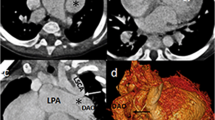Abstract
Purpose
We investigated retrospectively the usefulness of multidetector computed tomography (MDCT) in the preoperative diagnosis of interruption of the aortic arch (IAA).
Materials and methods
Seven neonates with IAA underwent enhanced MDCT before a surgical repair operation between April 2006 and March 2010. The MDCT procedures were performed using either a 16- or 64-MDCT scanner without electrocardiographic gating or respiratory arrest.
Results
High-quality CT images were obtained in all cases. One patient was diagnosed to be IAA type A, and 6 were diagnosed to be IAA type B (Celoria and Patton classification). The Celoria and Patton classification of IAA types and subtype classification by MDCT were confirmed by surgery.
Conclusion
Our results show that the information from MDCT was sufficient for a preoperative diagnosis of IAA and allowed omission of a cardiac catheter examination before surgery.
Similar content being viewed by others
References
Celoria GC, Patton RB. Congenital absence of the aortic arch. Am Heart J 1959;58:407–413.
Van Praagh R, Bernhard WF, Rosenthal A, Parisi LF, Fyler DC. Interrupted aortic arch: surgical treatment. Am J Cardiol 1971;27:200–211.
Gokcebay TM, Batillas J, Pinck RL. Complete interruption of the aorta at the arch. Am J Roentgenol Radium Ther Nucl Med 1972;114:362–370.
Flint JD, Gentles TL, MacCormik J, Spinetto H, Finucane AK. Outcomes using predominantly single-stage approach to interrupted aortic arch and associated defects. Ann Thorac Surg 2010;89:564–569.
Yang DH, Goo HW, Seo DM, Yun TJ, Park JJ, Park IS, et al. Multislice CT angiography of interrupted aortic arch. Pediatr Radiol 2008;8:89–100.
Kim JE, Newman B. Evaluation of a radiation dose reduction strategy for pediatric chest CT. AJR Am J Roentgenol 2010;194:1188–1193.
Smith AB, Dillon WP, Lau BC, Gould R, Verdun FR, Lopez EB, et al. Radiation dose reduction strategy for CT protocol: successful implementation in neuroradiology section. Radiology 2008;247:499–506.
Goo HW, Park IS, Ko FK, Kim YH, Seo DM, Yun TF, et al. CT of congenital heart disease: normal anatomy and typical pathologic conditions. Radiographics 2003;23:S147–S165.
Haramati LB, Glickstein FS, Issenberg HF, Haramati N, Crooke GA. MR Imaging and CT of vascular anomalies and connections in patients with congenital heart disease: significance in surgical planning. Radiographics 2002;22:337–349.
Kimura-Hayama ET, Melendez G, Mendizabal AL, Meave-Gonzalez A, Zambrana GF, Corona-Villalobos CP. Uncommon congenital and acquired aortic diseases: role of multidetector CT angiography. Radiographics 2010;30:79–98.
Leschka S, Oechslin E, Husmann L, Desbiolles L, Marincek B, Genoni M, et al. Pre- and postoperative evaluation of congenital heart disease in children and adults with 64-section CT. Radiographics 2007;27:829–846.
Roche KJ, Krinsky G, Lee VS, Rofsky N, Genieser NB. Interrupted aortic arch: diagnosis with gadolinium-enhanced 3D MRA. J Comput Assist Tomogr 1999;23:197–202.
Lupoglazoff JM, Sebag G, Bedu A. Three-dimensional gadolinium-enhanced magnetic resonance angiography in interrupted aortic arch. Cardiol Young 2001;11:443–444.
Dillman JR, Yarram SG, D’Amico AR, Hernandez RJ. Interrupted aortic arch: spectrum of MRI findings. AJR Am J Roentgenol 2008;190:1467–1474.
Ohtsuki S, Baba K, Kataoka K, Ohno N, Okamoto Y, Ishino K, et al. Usefulness of helical computed tomography in diagnosing pulmonary vein stenosis in infants. Acta Med Okayama 2005;59:93–98.
Kawano T, Ishii M, Takagi J, Maeno Y, Eto G, Sugahara Y, et al. Three-dimensional helical computed tomographic angiography in neonates and infants with complex congenital heart disease. Am Heart J 2000;139:654–660.
Momma K, Matsuoka R, Takao A. Aortic arch anomalies associated with chromosome 22q11 deletion (CATCH 22). Pediatr Cardiol 1999;20:97–102.
Momma K, Kondo C, Matsuoka R. Tetralogy of Fallot with pulmonary atresia associated with chromosome 22q11 deletion. J Am Coll Cardiol 1996;27:198–202.
Author information
Authors and Affiliations
Corresponding author
About this article
Cite this article
Sato, S., Akagi, N., Uka, M. et al. Interruption of the aortic arch: diagnosis with multidetector computed tomography. Jpn J Radiol 29, 46–50 (2011). https://doi.org/10.1007/s11604-010-0517-y
Received:
Accepted:
Published:
Issue Date:
DOI: https://doi.org/10.1007/s11604-010-0517-y




